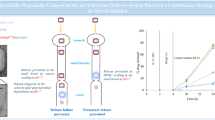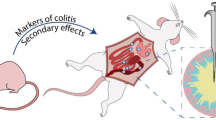Abstract
Dexamethasone-β-D-glucuronide is a potential prodrug for colonic delivery of the antiinflammatory corticosteroid dexamethasone. Previous studies [T. R. Tozer et al., Pharm. Res. 8:445–454 (1991)] indicated that a glucoside prodrug of dexamethasone was susceptible to hydrolysis in the upper gastrointestinal tract. Resistance of dexamethasone-β-D-glucuronide to hydrolysis in the upper gastrointestinal tract was therefore assessed. Conventional, germfree, and colitic rats were used to examine enzyme levels along the gastrointestinal tract to compare the stability of two model substrates (p-nitrophenyl-β-D-glucoside and -β-D-glucuronide) and to evaluate the prodrug dexamethasone-β-D-glucuronide. Hydrolytic activity was examined in the luminal contents, mucosa, and underlying muscle/connective tissues in all three types of rats. Enzymatic activity (β-D-glucosidase and β-D-glucuronidase) was greatest in the lumen of cecum and colon of conventional rats. In contrast, germ-free rats exhibited relatively high levels of β-D-glucosidase activity (about 80% of total activity in the conventional rats) in the proximal small intestine (PSI) and the distal small intestine (DSI). Rats with induced colitis (acetic acid) showed reduced levels of luminal β-D-glucuronidase activity in the large intestine; however, β-D-glucosidase activity was relatively unchanged relative to that of the conventional rat. Mucosal β-D-glucuronidase activity was significantly lower in the colitic rats compared with that in the conventional animals. Despite reduced luminal levels of β-D-glucuronidase activity in the colitic rats, there was still a sharp gradient of activity between the small and the large intestines. Permeability of the glucoside and glucuronide prodrugs of dexamethasone through a monolayer of Caco-2 cells was relatively low compared to that of dexamethasone. The results indicate that dexamethasone-β-D-glucuronide should be relatively stable and poorly absorbed in the upper gastrointestinal tract. Once the compound reaches the large intestine, it should be hydrolyzed to dexamethasone and glucuronic acid. Specificity of colonic delivery in humans should be even greater due to lower levels of β-D-glucuronidase activity in the small intestine compared with that in the laboratory rat.
Similar content being viewed by others
REFERENCES
G. Friedman. New steroid preparations. In T. M. Bayless (ed.), Current Management of Inflammatory Bowel Disease, B. C. Decker, Burlington, Ontario, 1989, pp. 56–57.
D. R. Friend. Colon-specific drug delivery. Adv. Drug Del. Rev. 7:149–199 (1991).
D. R. Friend (ed.). Oral Colon-Specific Drug Delivery, CRC Press, Boca Raton, FL, 1992.
E. Märta Ryde. Low-molecular weight azo compounds. In D. R. Friend (ed.), Oral Colon-Specific Drug Delivery, CRC Press, Boca Raton, FL, 1992, pp. 143–152.
D. R. Friend. Glycosidases in colonic drug delivery. In D. R. Friend (ed.), Oral Colon-Specific Drug Delivery, CRC Press, Boca Raton, FL, 1992, pp. 153–187.
J. P. Brown. Hydrolysis of glycosides and esters. In I. R. Rowland (ed.), Role of the Gut Flora in Toxicity and Cancer, Academic Press, New York, 1988, pp. 109–144.
T. N. Tozer, J. Rigod, A. D. McLeod, R. Gungon, M. K. Hoag, and D. R. Friend. Colon-specific delivery of dexamethasone from a glucoside prodrug in the guinea pig. Pharm. Res. 8:445–454 (1991).
D. R. Friend and G. W. Chang. A colon-specific drug-delivery system based on drug glycosides and the glycosidases of colonic bacteria. J. Med. Chem. 27:261–266 (1984).
D. R. Friend and G. W. Chang. Drug glycosides: Potential prodrugs for colon-specific drug delivery. J. Med. Chem. 28:51–57 (1985).
C. M. McCloskey and G. H. Coleman. In Organic Syntheses, Collected Vol. III, J. Wiley, New York, 1955, pp. 434–435.
R. N. Fedorak, L. R. Empey, C. MacArthur, and L. D. Jewell. Misoprostol provides a colonic mucosal protective effect during acetic-acid induced colitis in rats. Gastroenterology 98:615–625 (1990).
D. H. Lowry, N. J. Rosebrough, A. L. Farr, and R. J. Randall. Protein measurement with the phenol reagent. J. Biol. Chem. 193:265–275 (1951).
A. K. Mallet, C. A. Baerne, and I. R. Rowland. The influence of incubation pH on the activity of rat and human gut flora enzymes. J. Appl. Bacteriol. 66:433–437 (1989).
T. O. Rod and T. Midvedt. Origin of intestinal β-glucuronidase in germfree, monocontaminated and conventional rats. Acta Pathol. Microbiol. Scand. B 85:271–276 (1977).
I. J. Hidalgo, T. J. Raub, and R. T. Borchardt. Characterization of the human colon carcinoma cell line (Caco-2) as a model system for intestinal epithelial permeability. Gastroenterology 96:736–749 (1989).
I. J. Hidalgo, K. M. Hillgren, G. M. Grass, and R. T. Borchardt. Characterization of the unstirred water layer in Caco-2 cell monolayers using a novel diffusion apparatus. Pharm. Res. 8:222–227 (1991).
L. Hsu and A. L. Tappel. Lysosomal enzymes and mucopolysaccharides in the gastrointestinal tract of the rat and guinea pig. Biochim. Biophys. Acta 101:83–93 (1965).
L. Hsu and A. L. Tappel. Lysosomal enzymes of rat intestinal mucosa. J. Cell. Biol. 23:233–240 (1964).
S. H. Danovitch, A. Gallucci, and S. Waseem. Colonic mucosal lysosomal enzyme activities in ulcerative colitis. Am. J. Digest. Dis. 17:977–992 (1972).
J. Conchie and D. C. Macdonald. Glycosidases in the mammalian alimentary tract. Nature 1984:1233 (1959).
J. M. Rhodes, R. Gallimore, E. Elias, R. N. Allan, and J. F. Kennedy. Fecal mucus degrading glycosidases in ulcerative colitis and Crohn's disease. Gut 26:761–765 (1985).
J. G. H. Ruselar-van Embden and L. M. C. van Lieshout. Increased fecal glycosidases in patients with Crohn's disease. Digestion 37:43–50 (1987).
J. E. Yamani, C. Mizon, C. Capon, J.-F. Colombel, B. Fournet, A. Cortot, and J. Mizon. Decreased faecal exoglycosidase activities identify a subset of patients with active Crohn's disease. Clin. Sci. 83:409–415 (1992).
R. M. Batt and T. J. Peters. Effects of prednisolone on the small intestinal mucosa of the rat. Clin. Sci. Mol. Med. 48:259–267 (1976).
R. M. Batt and J. Scott. Response of the small intestinal mucosa to oral glucocorticoids. Scand. J. Gastroenterol. 17 (Suppl. 74):75–88 (1982).
P. R. Trumbo, M. A. Banks, and J. F. Gregory, III. Hydrolysis of pyridoxine-5′-β-glucoside by a broad-specificity β-glucosidase from mammalian tissues. Proc. Soc. Exp. Biol. Med. 195:240–246 (1990).
B. S. Wostmann and E. Bruckner-Kardoss. Oxidation-reduction potential in cecal contents of germfree and conventional rats. Proc. Soc. Exp. Biol. Med. 121:1111–1114 (1966).
H. Adlercreutz, F. Martin, T. Lehtinen, M. O. Tikkanen, and M. O. Pulkkinen. Effect of ampicillin administration on plasma conjugated and unconjugated estrogen and progesterone levels in pregnancy. Am. J. Obstet. Gynecol. 128:266–271 (1977).
G. Hawksworth, B. S. Drasar, and M. J. Hill. Intestinal bacteria and hydrolysis of glycoside bonds. J. Med. Microbio. 4:451–459 (1971).
W. Rubas, N. Jezyk, and G. M. Grass. Comparison of the permeability characteristics of a human colonic epithelial (Caco-2) cell line to colon of rabbit, monkey, and dog intestine and human drug absorption. Pharm. Res. 10:113–118 (1993).
Author information
Authors and Affiliations
Rights and permissions
About this article
Cite this article
Haeberlin, B., Rubas, W., Nolen III, H.W. et al. In Vitro Evaluation of Dexamethasone-β-D-Glucuronide for Colon-Specific Drug Delivery. Pharm Res 10, 1553–1562 (1993). https://doi.org/10.1023/A:1018956232628
Issue Date:
DOI: https://doi.org/10.1023/A:1018956232628




